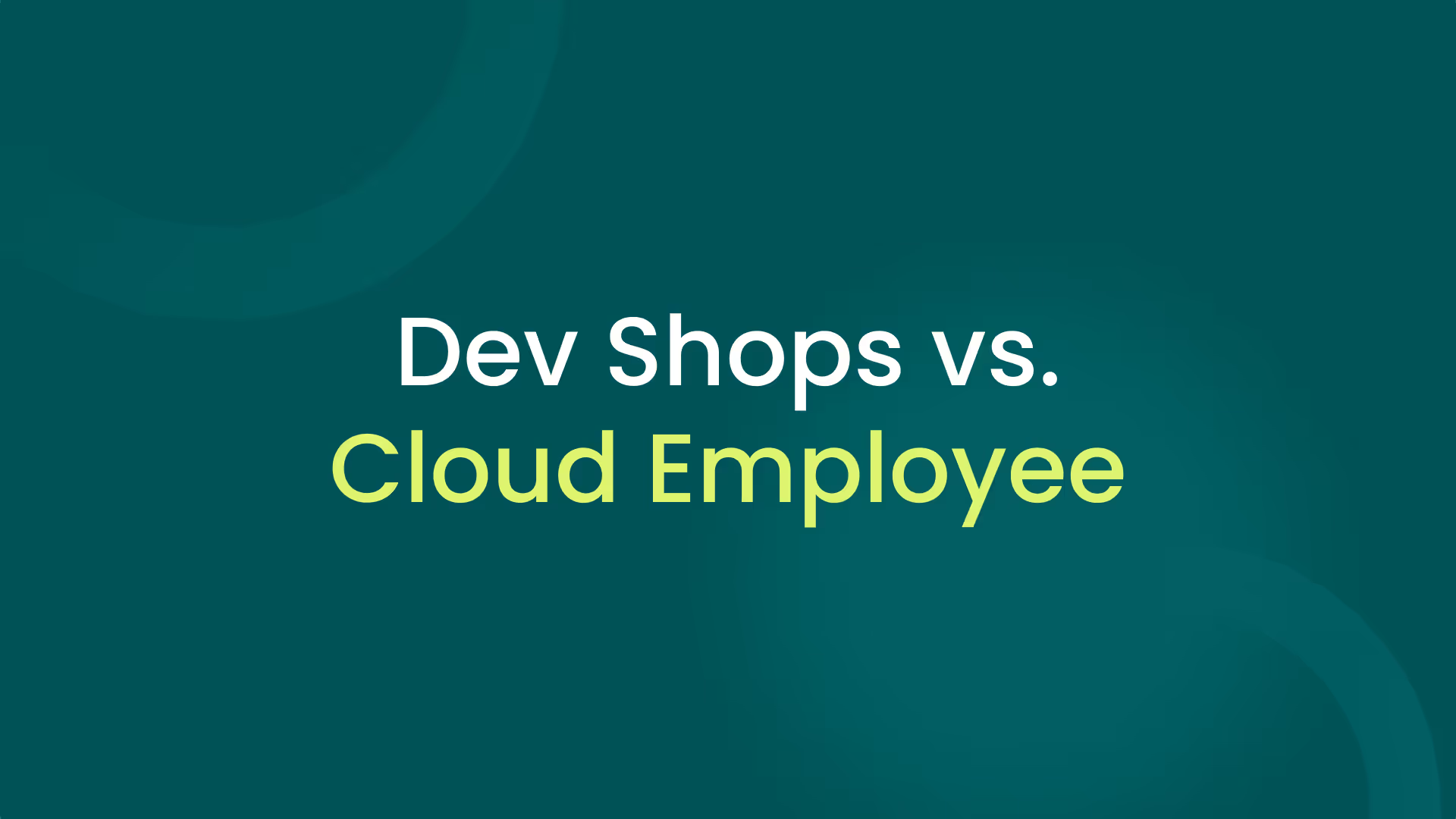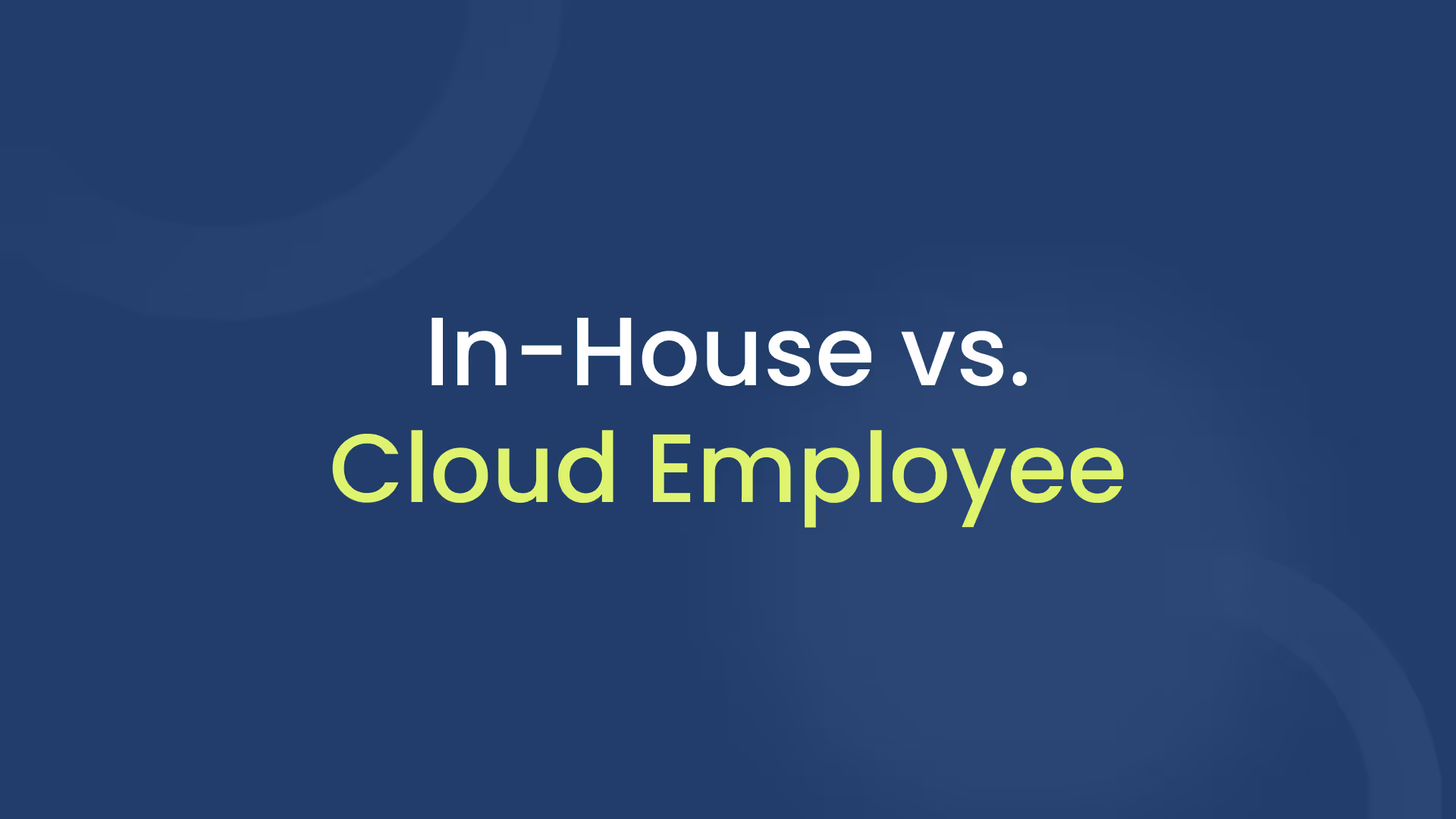Cloud Employee vs. Dev Agencies

📌 TL;DR
Development agencies promise turnkey delivery and breadth of skills but come with high costs, limited transparency, and diluted control. In 2025, agencies typically bill 4-6x more expensive than Cloud Employee. Agencies rotate staff between projects and prioritise billable hours, often misaligning with internal product goals. Cloud Employee provides the best alternative: Engineers vetted by a CTO-led process, embedded in your workflows, retained long-term (97%+ beyond two years).
Development Agencies in Context
For more than a decade, development agencies have served as a convenient solution for organisations seeking to deliver software projects without expanding permanent headcount. They range from boutique consultancies to large-scale IT services firms operating across finance, travel, logistics, e-commerce, healthcare, and more.
Agencies thrive on turnkey delivery, supplying developers, project managers, and designers under a single contract, making them particularly appealing for non-technical founders or enterprises outsourcing entire product lines.
But in 2025, this model is showing strain. For CTOs and CIOs operating within agile delivery environments, agency contracts often clash with the need for continuous iteration, cost control, and direct ownership of engineering outcomes. Agencies retain control of process, people, and delivery. The result: reduced transparency, slower feedback loops, IP retention risk, and codebases that diverge from internal standards.
How Development Agencies Work (Business Model)
Development agencies typically operate on fixed-price or time-and-materials contracts.
- For clients: The agency owns the project scope, manages developers, QA, and delivery schedules, and reports progress at defined milestones.
- For developers: Engineers are employed by the agency, not the client, and may be assigned across multiple projects simultaneously. Their priorities are governed by agency leadership, not by your product roadmap.
The pitch to clients is simple: immediate delivery capacity without the operational weight of recruitment, HR, or people management. But the trade-off is structural, the more an agency controls, the less you do.
Process and Delivery Model of Development Agencies
Agencies are designed to deliver outcomes independently. A typical engagement follows this pattern:
- Project scoping: Requirements are defined upfront, often under commercial pressure to lock in cost.
- Team allocation: The agency assigns available resources, sometimes mixing senior leads with junior delivery staff.
- Project management: The agency drives the roadmap, task prioritisation, and quality assurance using its own internal frameworks.
- Delivery ownership: Source code, documentation, and architecture often reside within the agency until project handoff.
- Handover or retainer: Once delivered, teams are reassigned, leading to continuity challenges for clients wishing to iterate further.
For non-technical founders or short, well-defined projects, this model works. But for CTOs managing complex, evolving systems, the agency delivery model fragments control, particularly when agile sprints depend on tight alignment between engineering, product, and user feedback. The risks associated with the potential loss if IP in this model also can’t be understated, as in many cases resources will be scaled up and down across multiple projects in the agency model.
Evaluation: Strengths and Weaknesses
Strengths
- Turnkey capability: Ideal for non-technical founders or project-based organisations.
- Process maturity: Established agencies bring project templates and delivery frameworks.
- Breadth of expertise: Design, QA, and PM disciplines available under one umbrella.
Weaknesses
- Loss of control: Agencies manage prioritisation, architecture, and workflow, often misaligned with internal goals. Control loss includes IP, as resource can be pulled or placed across multiple projects at any time.
- Variable talent quality: Senior consultants lead proposals, but day-to-day work is often delivered by junior or rotating staff.
- Incentive mismatch: Agencies optimise for billable hours, not long-term product performance.
- High cost base: US rates average $150–$250/hour ($26,000–$40,000/month); UK averages £80/hour (~£14,700/month).
For scaling tech companies, these weaknesses increasingly outweigh the benefits.
Cloud Employee’s Model: Control and Continuity without Agency Overhead
Cloud Employee replaces the agency’s black-box delivery model with transparent, embedded collaboration. Engineers are sourced, vetted, and employed by Cloud Employee but work as integral members of your team, following your product roadmap, tools, and engineering standards.
Process and Delivery Model
Cloud Employee’s delivery structure is built for CTOs who want control of their backlog without operational friction:
- CTO-led technical vetting: Every engineer is assessed through pair programming and live problem-solving to guarantee senior-level capability.
- Rapid onboarding: Engineers can join in less than 2 weeks, cutting months from typical hiring timelines.
- Embedded collaboration: Developers adopt your tools, rituals, and delivery cadence, working as peers within your engineering organisation. Developers are fully dedicated to your organisation.
- Retention framework: Cloud Employee manages payroll, benefits, and career development, sustaining 97%+ retention beyond two years, far exceeding typical agency churn.
- Compliance and HR: Cloud Employee handles all compliance, payroll, L&D, and benefits administration in-region, insulating clients from risk.
How this stacks up against agency delivery:
- Agencies control workflow and priorities; Cloud Employee gives control back to your leadership.
- Agencies rotate staff between clients; Cloud Employee engineers are fully dedicated to you.
- Agencies manage outputs; Cloud Employee enables you to manage outcomes directly.
- Agencies sell speed; Cloud Employee delivers speed and transparency.
Strengths of Cloud Employee vs Development Agencies
Interpretation:
- Cloud Employee outperforms agencies on cost, control, retention, and transparency, the levers most critical to CTOs operating agile teams.
- Agencies remain suitable for turnkey projects without internal leadership bandwidth, but for organisations building long-term product capability, Cloud Employee’s embedded model delivers more sustainable velocity and governance.
Pricing Review*
Development Agency Rates
- USA: $150–$250/hour ($26,000–$40,000/month per developer equivalent)
- UK: £80/hour (~£14,700/month)
Cloud Employee Rates
- LATAM engineers: $6,000/month all-inclusive
- Philippines engineers: $4,500/month all-inclusive
Note*: These are average costs as a representation of rates from Cloud Employee’s on the ground knowledge, these vary based on seniority, skills, experience, location, and are open to change.
Cost Efficiency Summary:
The numbers are unambiguous: Cloud Employee delivers equivalent or superior engineering talent at a fraction of the cost, with higher stability and direct management control.
Case Studies: Where the Model Wins
- Willo: Initial requirement of 2 engineers sourced & onboarded in 3 weeks. Read case study
- Mercato: To accelerate product development and scale more confidently, Mercato partnered with Cloud Employee - building a remote development team in the Philippines to support key platform upgrades. Read case study
- CleanLink:Team of 3 hired in the Philippines in 2 weeks. Read case study
Executive Insight
Seb Hall, CEO and Co-Founder of Cloud Employee, summarises the shift:
Development agencies sell speed, but rarely transparency. Cloud Employee combines both with rapid access to world-class developers, but under your leadership, following your roadmap.
Bottom Line
Development agencies offer convenience and breadth but at high cost and with diluted control, a model increasingly misaligned with agile, product-led delivery.
For CTOs needing to extend capability without surrendering visibility, Cloud Employee provides a cleaner alternative:
- Engineers you manage directly, not through an intermediary.
- Predictable, all-inclusive costs at 50–75% below agency rates.
- Retention and continuity that protect delivery velocity.
Cloud Employee turns what agencies deliver as a project service into an integrated extension of your engineering function, fast, accountable, and built for long-term product ownership.






